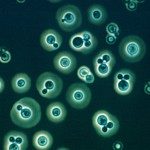Link to Pubmed [PMID] – 26678748
FEMS Yeast Res. 2016 Feb;16(1):fov111
Biofilms are a source of therapeutic failures because of their intrinsic tolerance to antimicrobials. Candida glabrata is one of the pathogenic yeasts that is responsible for life-threatening disseminated infections and able to form biofilms on medical devices such as vascular and urinary catheters. Recent progresses in the functional genomics of C. glabrata have been applied to the study of biofilm formation, revealing the contribution of an array of genes to this process. In particular, the Yak1 kinase and the Swi/Snf chromatin remodeling complex have been shown to relieve the repression exerted by subtelomeric silencing on the expression of the EPA6 and EPA7 genes, thus allowing the encoded adhesins to exert their key roles in biofilm formation. This provides a framework to evaluate the contribution of other genes that have been genetically linked to biofilm development and, based on the function of their orthologs in Saccharomyces cerevisiae, appear to have roles in adaptation to nutrient deprivation, calcium signaling, cell wall remodeling and adherence. Future studies combining the use of in vitro and animal models of biofilm formation, omics approaches and forward or reverse genetics are needed to expand the current knowledge of C. glabrata biofilm formation and reveal the mechanisms underlying their antifungal tolerance.



